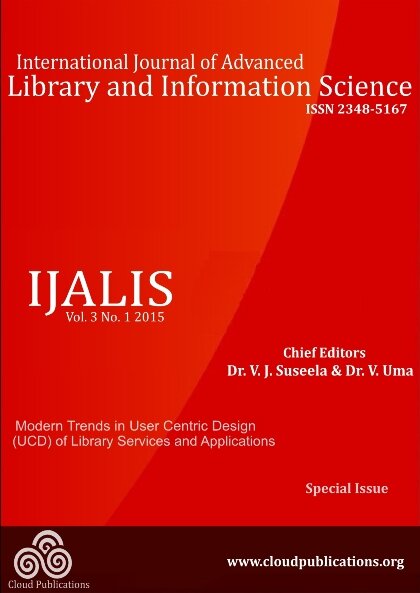
Modern Trends in User Centric Design (UCD) of Library Services and Applications
Abstract
Libraries as repositories of knowledge, information and resources need to be associated with structuring of information systems, services, spaces and objects for their users to retrieve his information. The library is the channel for connecting 'the user' to information sources. Based on the concept, several user services have been created by the libraries over the period such as books lending, cataloguing, document delivery, interlibrary loan, photocopy of articles, referral, and reference etc. in addition to creation of documentation services or procuring secondary services like - Abstracts & Indexes of Journal articles, bibliographic, current awareness as well SDI bulletins etc. from external scientific agencies. The ultimate objective of the libraries and information centres is always to design and redesign the library services considering user needs from time to time. The international standards developed by ISO for Human-centred design for interactive systems also formed the basis for many User Centric Design methodologies for libraries and information centers.
The ‘user’ is the dynamic component that enforces the design of library services, organization and collection of information as well as learning resources. Several managerial strategies, operations, applications and the best practices are being evolved in view of the ever changing user requirements and also efforts are put to explore new methodologies to know the user needs. The emphasis on User Centric Library (UCD) models and services is becoming more in the digital era with the increase of information, resources and transformation of physical format of information, mode of dissemination through speedy telecommunication channels and especially due to advanced ICT applications in libraries and information centres irrespective of their type.
The prime theme of special issue - ‘User-centric design (UCD) of library services, practices, models and applications” to elicit some best practices, experiences, explorations and thoughts to add to the knowledge in this direction to enhance the quality of library resources and services and also to evaluate them in terms of user needs. Thus the user studies, user information or user research and methodologies play vital role in the cyclic process of UCD.
This issue is special as the topic is hot with real issues that librarians need to be aware and tackle the information issues of users for which the librarian himself need to be information literate with latest updates. The present issue is thus focusing on the user needs and also means/ways of applying ‘user centric design’ concepts to the development of library systems as well as the services. The application of strategic management principles for moulding library environments more user friendly was dealt supplemented by some case studies based on results of surveys in different organizations. The studies attempted to explore the level of users’ awareness of ICT advancements and availability of e-resources (including even Urdu language studies); those have been spreading in almost all campuses in the country since more than two decades. There were attempts to assess the use of Internet, e-resources and to elicit information about the user’s expressions/preferences on resources, physical library buildings, requirements and impediments in accessing resources in the transformation of libraries in electronic/digital era.
The primary emphasis was however laid on the academic institutions, but it has not exempted corporate environment. The libraries and information centres have been depending on tools to locate, access and share information. In this context, studies on search engines as the most important means of retrieving information through web sources and their latest developments as per user’s requirements; the web 2.0 tools to facilitate user interaction as well as feedback and the document delivery tools for sharing information was analyzed. Since libraries are service organizations, they should be made customer driven (user) by adapting ICT environment in campuses and libraries by implementing library automation, acquisition of e-resources and employing web based tools etc. emphasizing the need to update/evaluate the tools, services in the light of changing users requirements from time to time.
Keywords
Refbacks
- There are currently no refbacks.

This work is licensed under a Creative Commons Attribution 3.0 License.

